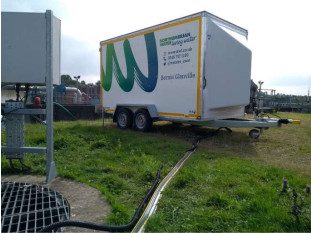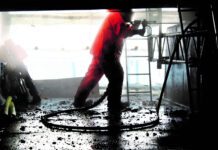
The need for a bespoke monitoring system led utility firm Northumbrian Water to the development of a pair of towable trailers equipped with analytical equipment for continuous measurement. It was a design task for which they approached instrumentation expert Pollution & Process Monitoring (PPM). Here, PPM explains what was involved.
There are many potential difficulties with putting together a complete bespoke monitoring station of this kind, and it is especially challenging to pre-mount this kind of instrumentation within a towable trailer environment. For one thing, the interior needs to be adapted to house the analytical equipment – and this is on top of the usual considerations of sample delivery, sample pre-treatment, sample distribution, automatic compressed air cleaning, and reagent bunding.
The roof of the trailer had to be insulated, the walls had to be adapted to take the weight of the instrumentation, and bench top space had to be made available for the scientists who would later be using it to carry out analytical measurements. Base units were installed to provide storage during transit. Lighting and heating also had to be incorporated.
The two trailers were similar with slight differences. One was intended to capture data at the inlet to the treatment works and was measuring raw sewage. The other trailer was designed to make measurements after the treatment process, on the final effluent.
Both trailers were equipped with instrumentation to analytically measure ammonia, iron, total phosphate and alkalinity. Probe measurement of pH, COD and temperature was also incorporated in both trailers. The inlet trailer was configured for redox and conductivity measurement while the outlet trailer was configured for turbidity. Spare access points were made available in both trailors to accommodate retrofitting of additional probe parameters.
The signals from all the instruments were wired back during the initial fabrication of the analytical trailers, to a common signals box so that they could be simply connected into an NWG approved telemetry outstation for remote data capture.
With this kind of design, it is important to provide for routine removal of the probe technology for maintenance, and to ensure that this will be as effortless as possible. And to isolate the sample during this process, so that the system can continue to measure other parameters.
Sample acquisition is another critical element. None of the instruments can perform reliably without receiving a continuous supply of sample. The sample has a propensity to foul and rag, so this is a challenge. Sample pump requirements vary from site to site, but the approach should be able to accommodate these variations without extra effort. PPM worked with NWL to test and approve a funnel/strainer arrangement that would reliably convey process sample to the pumping arrangement. Transfer lines are automatically cleaned via back-purging of compressed air at regular intervals. The pumping system is contained within the trailer, which simplifies commissioning.
A mains power supply (240 VAC) is needed. The strainer arrangement and drainpipe have to be installed in an appropriate place for a representative sample to be taken with the drain routed to a suitable drain point. Once the instruments are powered the analysis may begin.
Being able to deploy the trailers quickly and obtain real time data is very helpful for site profiling. It saves time and provides a more detailed picture of process events, supporting efforts to optimise the quality of water treatment and environmental performance.
The mobile trailers will be deployed on treatment sites across the region, bearing the names of past employees – an element of the company’s legacy project.
Laura Evans, a project sponsor, has commented: “We’ve spent the last year working collaboratively with supplier Pollution & Process Monitoring to design and develop the SWAT trailer to help us improve that process and I’m so proud that we’ve now got a real-life, working product”.
“The trailers will provide a vast amount of information that we’ve never had before, sending information about the wastewater quality 24/7 and removing the need to take samples that only tell you about the wastewater at that moment in time.”

“This will give us much better insight into the wastewater flows entering and leaving our works and will help to make us more efficient, both in terms of making sure we’re using the right amount of chemicals to treat the water, as well as proactively identifying any potential issues.”
“We’re passionate about protecting the environment and more importantly, using the SWAT trailer means we’re able to better monitor and improve the quality of the final treated product from our works, before it’s returned to the environment”.
Mark Gibson, Operational Technology Engineer, commented: “PPM have proven to be an excellent collaborative partner.” He said the firm “have been considerate and flexible, incorporating specific NWL design and instrument specification requirements.”
“PPM have produced a high-quality product – one which leaves us best placed to make on-line measurements on very demanding applications”.
Site attendance will take place in the autumn to help commission the trailers and provide training on the operation and maintenance of various aspects of the installation.
The trailer monitoring project is referred to as SWAT (Site Wastewater Analysis Trailer) by Northumbrian Water. The project was managed by Loren Jennings, project sponsor was Laura Evans and Technical Support was provided by Mark Gibson (Operational Technology Engineer). Mark was responsible for the instrument selection and liaised with PPM to define the overall design, from the initial concept to the final outcome.
For more information about PPM see the firm’s website.






